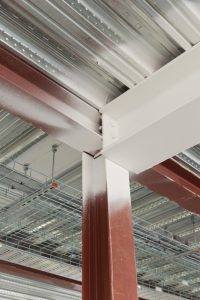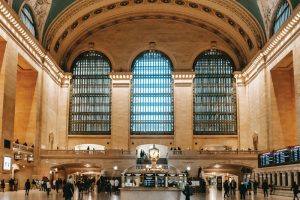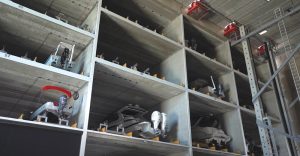The Role of Architectural and Structural Elements in Facility Fire-Protection Schemes
When most people think of fire protection, their minds go straight to fire alarm systems and sprinkler systems. In reality, these two systems are just small pieces of a larger puzzle. Fire protection encompasses a “system of systems” that work together to provide occupant and facility protection in a fire or other emergency. These systems often include many other building systems that are generally not at the top of mind when considering Fire Protection. For example, if a facility has duct smoke detection, HVAC controls may shut down air handling equipment to prevent the spread of smoke. In low-light environments, such as theaters and nightclubs, lighting controls that automatically turn on lights may be part of the life safety systems to ensure occupants have adequate light to evacuate. Fire-resistance-rated construction to provide compartmentation, exit separation, and protected egress paths are also part of these systems, which make up the facility’s fire-protection envelope. Other passive fire-protection systems include the facility’s structural aspects.
While many other types of building systems contribute toward the overall facility fire-protection scheme, this article focuses on facility design and protection related to the facility structural system(s). Common sense tells us that the materials providing structural support for a building are subject to damage from the extreme temperatures of a fire. For example, concrete can spall (crack or delaminate from substrates), and steel structural members are subject to yield and deformation from heat exposure during a fire. The goal of structural fire-protection requirements is to ensure that the facility can withstand fire conditions long enough to allow for facility egress. Still, it is also concerned with ensuring that firefighters can perform interior firefighting and search and rescue operations without risking a structural failure.
The Basics
In a fire scenario, a facility is subject to extreme environmental conditions such as heat and water in a relatively short amount of time. As a result, the goals of structural fire protection aim to ensure that a building can withstand these conditions throughout the egress period and through the fire-fighting response and overhaul periods.
Perhaps the most familiar aspect of structural fire protection is related to the fire-resistance requirements of the structural components of the system. Model building codes, including the International Building Code (IBC), specifically prescribe fire-resistance rating requirements for facility structural elements based on the building occupancy, height, and area. Furthermore, fire codes, including the International Fire Code (IFC), may include additional structural fire resistance requirements based on special hazards or uses. Fire-resistance rating requirements for building elements prescribed in the IBC (as well as other model codes) also allow a reduction in the required fire-resistance ratings for certain building elements under specific conditions, such as the inclusion of fire sprinkler protection.

The method by which the required fire-resistance ratings for building elements can be achieved depends on the construction materials. Spray-applied fire-resistive material (SFRM) is one of the most common methods used to protect structural steel. In areas where steel might be exposed, intumescent coatings may be used instead. Enclosing or “boxing out” structural elements using a listed fire-resistive assembly is also a common approach. Concrete structural elements may achieve the required fire-resistance rating depending on the size and aggregate without additional materials to coat or box out the building elements. Structural assemblies are tested by a laboratory as outlined in ASTM E119, Standard Test Methods for Fire Tests of Building Construction and Materials, or UL263, Standard for Safety Fire Tests of Building Construction and Materials, to determine the appropriate methods for fire-proofing structural elements.
The above describes the basics of structural fire-protection requirements. What are the potential pitfalls and considerations often overlooked in facility design related to structural fire protection?
Existing Buildings
In existing buildings that may be undergoing renovation, addition, or changes in use or occupancy, there may not be enough data available from the original construction to determine the fire-resistance rating of the existing structural frame of the building. In cases where changes of use or occupancy or significant renovations or additions require that the entire building or portions within the area of work be upgraded to the current code, this can present a challenge in developing the fire-protection envelope. In these cases, there are several options for compliance.
- Presume that existing elements do not have an inherent fire-resistance rating and provide fire-resistive assemblies or materials in accordance with a new assembly listed by a nationally recognized testing laboratory. While this option is valid, it can unnecessarily drive up facility construction costs when the structural elements have some fire-resistive features.
- Calculate the fire resistance. IBC Section 722, Calculated Fire Resistance, provides a methodology for determining the fire resistance via a mathematical calculation based on the building materials and configuration. For example, if an 8-inch-square concrete masonry column is enclosed in 2 layers of ½-inch type X gypsum wallboard, Section 722 can be used to estimate the fire resistance. The masonry column would be assigned a fire-resistance rating of 1-hour while each of the two layers of gypsum would be assigned a fire resistance of 25 minutes each, meaning that it can be assumed that the column has a fire-resistance rating of 110 minutes or 1.8 hours.
However, it is important to note that how the assembly was constructed can impact the fire-resistance rating. For example, if the gypsum wallboard in the above example is not properly attached to and sealed where it joins other building elements such as the floor slab or roof deck, that weak spot could lower performance compared to the calculated fire resistance. As a result, the design team must consider that such joints may require additional attention and engineering to ensure the required fire resistance can be maintained at the joints.
Archaic Building Materials
When dealing with historic structures, determining the fire-resistance rating is even more difficult. However, there are guides available to assist engineers with estimating the fire resistance of archaic building materials. In cases where the structure is part of the facility’s historic fabric, the fire-resistance rating is of concern and whether archaic materials and age have reduced the load-carrying ability of such materials. It may be necessary to spend extra time understanding archaic construction methods to ensure that recommended structural protection approaches are not undermined by construction methods unfamiliar in the industry today. Special consideration and close coordination between fire protection and structural teammates are necessary to ensure that design approaches aimed at improving structural fire resistance while preserving historic fabric do not degrade these materials further. Understanding how archaic materials that are not in use today may react with newer materials and coatings may be difficult to determine. There may be conditions where engineering judgments must be applied, as there may not always be adequate data or viable means to test assumptions. In such cases, it may be necessary to involve historic preservationists, material science experts, or others who can offer expertise on the best ways to preserve historical materials while still meeting the required level of fire resistance.

Many historic buildings still have wood roofs, and replacing these structures is not always feasible or desirable. There are intumescent products available for application on the underside of roof structures to increase the fire resistance of these roofs. However, the application can be complicated, especially when attic spaces below these roofs are used for equipment, are heavily congested, or have limited access or low clearances.
Fire-Resistance-Rated Building Elements
One of the more common oversights made during facility design is failure to consider the requirements of IBC Section 704.1 (2018 Edition). This section indicates that structural members must provide the required fire-resistance rating as specified for the building construction type and notes that the structure shall not be less than the ratings required for the fire-resistance-rated assemblies supported by the structure. For example, a six-story Business Occupancy of Type IIA Construction requires only a 1-hour fire-resistance rating for the primary structural frame. However, a six-story building is also required to have 2-hour fire-resistance-rated exit stair and shaft enclosures. Therefore, to comply with Section 704.1 of the IBC, the structural frame supporting the stair and shaft enclosures must have at least a 2-hour fire-resistance rating despite only a 1-hour rating required for the primary structural frame by Table 601 of the IBC.
This is also an important consideration where a facility may have horizontal shafts penetrating a wall assembly. This kind of rated horizontal shaft is often necessary where stair pressurization equipment cannot be co-located with the stair shaft and must be ducted into the stair shaft from a mechanical room. For example, suppose that a horizontal shaft is required to have a 2-hour fire-resistance rating, and it is the intention to use the wall assembly it penetrates to support the horizontal shaft. In that case, that wall now requires a 2-hour fire-resistance rating as it is the supporting element. If structural elements other than walls support the shaft, they also would require an increased fire-resistance rating.
Facility Lifecycle
Lifecycle issues can significantly impact the integrity of structural fire-protection components in a building. Take into consideration that SFRM (spray-applied fire-resistive material) can become brittle and can be degraded or completely removed by mechanical impact. Therefore, installing SFRM in areas of the facility where electrical or mechanical equipment is housed could mean a higher likelihood of mechanical impact by ladders or even intentional removal to route new equipment connections. While most owners know and understand that their fire alarm system requires annual inspection and testing, it is rare to find an owner checking the integrity of their SFRM regularly throughout the building lifecycle. However, damaged SFRM reduces the fire-resistance rating of the structural elements it is intended to protect. For clients who require regular auditing for fire protection and life safety, damaged SFRM is a frequent finding. Therefore, the design team should avoid a blanket specification of SFRM throughout a facility without considering areas where mechanical impact might be considered likely due to operations or co-located equipment and consider using a different structural fire-protection material in those areas.
Intumescent coatings may be more durable than SFRM, but they are still subject to potential lifecycle issues. For example, consider a convention center with an exposed steel structure in an event hall. Intumescent coating is an excellent option for maintaining an industrial aesthetic even where a structural frame requires fire resistance. It looks more like paint, although it is required to be applied in thicker coats. The required depth of the coating depends on the required fire-resistance rating and the specific product being applied. Once it dries, most intumescent coatings are permitted to be covered by a decorative surface finish such as paint. However, when intumescent coatings are exposed to high temperatures, such as those from a fire, the intumescent product expands, sometimes to more than 100 times the original thickness. This then functions as an insulator, thus prolonging the integrity of that element during a fire. Like SFRM, intumescent coatings are also subject to degradation through mechanical damage over the building lifecycle. While it is less brittle than SFRM, chips, dings, or even sanding the surface to change the paint color can reduce the fire-resistive performance, especially if sanding reduces the depth of the intumescent coating.
Weight of Sprinkler Water
When SEs think of structural fire protection, they usually consider how to protect the structure from fire. However, the structure also needs to be protected from the effects of an activated fire sprinkler system. Consider, for example, a rack storage facility with open-top plastic bins or absorbent products. When a sprinkler activates, open storage containers and absorbent materials can absorb water or fill with water, causing increased structural loads on the rack assembly. However, this issue is not reserved to just rack or shelf storage conditions. Consider, for example, automated dry boat storage. These facilities allow the boat owner to pull their watercraft into a slip and enter a code into an automatic storage and retrieval control unit. A crane that looks like a boat forklift removes the boat from the slip and places it in a vertical dry storage bay. The sprinkler protection systems for these indoor vertical boat storage facilities are typically very robust. They are designed to deliver a large sprinkler density, as fiberglass boats with upholstery (floor covering and built-in benches/seats) stored in vertical arrangements constitute a relatively high-challenge fire necessitating aggressive sprinkler design discharge densities. However, even with drainage plugs open, the boats fill with water from a sprinkler system activation faster than the drains can empty them. The increased weight of water sitting in these boats could easily cause the collapse of the storage facility if the structure is not designed to anticipate the additional weight of water-filled boats. In addition, it can be a challenge to determine what design load to use for scenarios where additional structural loads are caused by sprinkler activation. The additional load varies as the size and capacity of stored products vary, so a conservative approach using the worst-case scenario is warranted.

In closing, the structural design of a facility ties into the system of systems that defines the full Fire-Protection envelope. Therefore, understanding how structural design and protection tie into the facility’s fire-protection goals is vital to ensuring occupants, first responders, and investments are acceptably protected in a fire emergency.■
